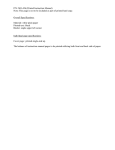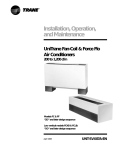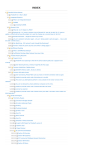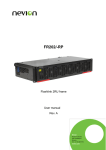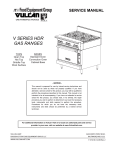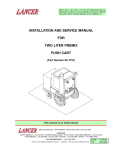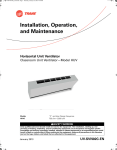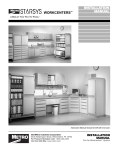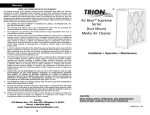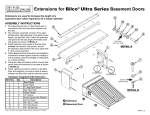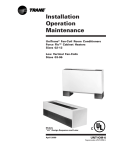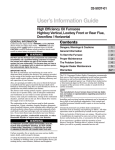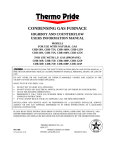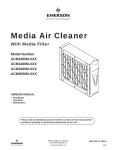Download OIL-FIRED CENTRAL FURNACE
Transcript
OIL-FIRED CENTRAL FURNACE Installation, Operation, And Service Manual With Users Information Section Models: VH-BBP VH-BNP VC-BBP VC-BNP VLF-BBP VLF-BNP VLR-BBP VLR-BNP c WARNING: • Do NOT store or use gasoline or other flammable vapors and liquids in the vicinity of this or any other appliance. • Improper installation, adjustment, alteration, service, or maintenance can cause a fire or explosion resulting in property damage, personal injury, or loss of life. For assistance or additional information consult a qualified installer or service agency. These instructions should be: • read prior to installing the furnace. • retained for reference by qualified service personnel. • reviewed before performing any service or maintenance. Thermo Products, LLC 5235 West State Road 10 North Judson, Indiana 46366 Made in USA MO-499 ECN 5396-MA 141211 Contents SECTION Notice to the Installer PAGE .................................................................................................. 4 INSTALLATION GUIDELINES ...................................................................................... Codes ................................................................................................................. Installation Location ............................................................................................ Closet and Alcove Installation ............................................................................. Standard Clearances .......................................................................................... Air for Combustion and Ventilation ..................................................................... Chimney Inspection ............................................................................................ Flue / Chimney / Vent Connector ........................................................................ Power (Side-Wall) Venting – Important Note Regarding ..................................... Draft Regulator .................................................................................................... Duct Work and Air Conditioning .......................................................................... Air Filter Mounting ............................................................................................... Electrical Connections ........................................................................................ Room Thermostat ............................................................................................... Combustion Chamber ......................................................................................... Oil Burner and Oil Nozzle Installation .................................................................. Fuel System Installation ....................................................................................... Horizontal / Counterflow Furnace Setup ............................................................. 5 5 5 6 6 7 10 10 11 11 12 12 14 14 15 15 17 18 INITIAL OPERATION OF THE FURNACE .................................................................... Initial Burner Operation ....................................................................................... Supply/Return Airflow and Air Temperature ........................................................ Furnace Limit and Blower Controls ..................................................................... Room Thermostat ............................................................................................... Instructions to Our Customer / End User ............................................................. 19 19 21 23 24 24 SERVICE ....................................................................................................................... Troubleshooting .................................................................................................. Flame Sensor (“Cad Cell”) Checkout Procedure ................................................ Replacement Parts ............................................................................................. 26 26 30 30 MAINTENANCE ............................................................................................................. Air Filter(s) ........................................................................................................... Oil Burner ............................................................................................................ Blower and Motor ................................................................................................ Heat Exchanger .................................................................................................. Flue and Chimney ............................................................................................... 31 31 31 31 31 33 USERS INFORMATION ................................................................................................. Operating Instructions ........................................................................................ Oil Supply ........................................................................................................... Extended Shutdown ........................................................................................... Combustion Air and Ventilation Supply ................................................................ Inspection Areas ................................................................................................. 34 34 35 36 36 36 2 APPENDIX A: SOURCES FOR REFERENCED STANDARDS ................................... 38 APPENDIX B: ELECTRICAL DIAGRAMS ..................................................................... 39 APPENDIX C: SPECIFICATION SHEETS .................................................................... 41 APPENDIX D: REPLACEMENT PARTS ....................................................................... 47 3 Notice to the Installer Installation of this oil-fired furnace must be performed by a qualified installer in accordance with all local codes and authorities having jurisdiction. In the absence of local governing codes, installation shall conform to these instructions and to the regulations of the National Fire Protection Association’s Standard for the Installation of Oil-Burning Equipment, NFPA 312001, and the National Electrical Code, ANSI/NFPA 70-2002, or the latest editions thereof. A qualified installer, also referred to in this instruction manual as a “qualified heating contractor”, is an individual, or agency, properly licensed and experienced to install and service oil-burning equipment in accordance with all local codes and ordinances. Material and Workmanship This furnace was built with the highest quality materials and attention to workmanship. However, omissions and defects occasionally occur. Before installing the furnace, inspect the furnace thoroughly. If missing parts, defective material, or poor workmanship are evident, report the model and serial numbers imprinted on the furnace rating label to the seller for adjustment. Packaging A complete furnace is contained within a single package. The factory completed all feasible assembly. However certain components including draft regulator and, if supplied, door handle, air filter(s), and air filter rack(s), must be assembled to the furnace, or the venting system, in the field. Refer to the assembly instructions. Shipping Damage If this furnace was damaged during transit, please immediately request the transportation company inspect the furnace and issue a concealed damage report. The party receiving the furnace should file the claim for shipping damage. Report any shipping damage immediately. It is absolutely essential that a damage report be obtained. If a concealed damage report is not obtained, we cannot provide assistance in recovering your claim against the transportation company. Warranties c WARNING: The manufacturer of this equipment assumes no liability for any damages resulting from unauthorized modifications made to the furnace, or any components thereof, or improper installation of the furnace in the field. Furthermore, any such field modifications VOID THE WARRANTY and place responsibility for safe and reliable operation of the furnace on those who performed the modification(s). Complete and return any enclosed warranty cards. These must be on file to verify installation dates for replacement of any warrantied part(s). 4 INSTALLATION GUIDELINES Codes All local codes and regulations take precedence over the instructions in this manual and shall be followed accordingly. In the absence of local codes, this installation must conform to these instructions and to the regulations of the National Fire Protection Association (NFPA) publications, the Standard for the Installation of Oil-Burning Equipment, NFPA 31-2001, and the National Electrical Code, ANSI/NFPA 70-2002, or the latest editions thereof. To obtain copies of these publications for a fee, contact the NFPA at the address given in Appendix A of this manual. Installation Location c WARNING: • These furnaces are designed for indoor installation ONLY. • These furnaces are NOT to be used as construction heaters. • DO NOT hang the horizontal / counterflow furnace from a structure, or surface, by any integral part or fastener of the furnace. The furnace was not designed to support itself in this manner. In as much as practical, the furnace should be positioned near a chimney or vent and should be centralized with respect to the air distribution system. For a utility room installation, the entrance door must be wide enough to permit the largest part of the furnace to pass through the doorway or allow sufficient clearance to permit the replacement of another appliance, e.g. a water heater, in the room. If the furnace is installed in a residential garage, it must be installed so the burner is located higher than 18 inches above the floor, unless the required combustion air is taken from the exterior of the garage. Also, the furnace must be located or protected to avoid physical damage from impacts by vehicles. Highboy and lowboy furnace models must rest on sturdy, stable, and level surfaces. The horizontal / counterflow model may be mounted on a level surface, as described above, or it may be suspended from an overhead structure or surface. If this model is suspended from hanger rods, support the furnace from the bottom casing surface at three (3) places, across both ends of the casing and across the casing, near the middle of the furnace. Generally, a simple support frame for the furnace can be fabricated from structural steel angle, threaded steel rod, and fastener hardware, refer to Figure 1. Adjust the height of the support angles to level the unit in position. 5 Figure 1: Recommended Support Frame for Horizontal / Counterflow Furnaces Closet and Alcove Installation All furnace models may be installed in a closet or alcove on combustible flooring with specified (standard) clearances to combustible construction. The horizontal / counterflow furnace model requires an optional combustible surface-mounting base (model # VC-BASE) for vertical installation (i.e., counterflow configuration) directly on combustible materials, refer to Figure 2. Figure 2: Counterflow Furnace Combustible Surface-Mounting Base Standard Clearances Standard clearances are mandatory minimum clearances from heated surfaces of the furnace to combustible materials to assure protection from fire hazard during furnace operation. (Refer to the Standard for the Installation of Oil-Burning Equipment, NFPA 31-2001, for definitions of combustible and non-combustible materials.) 6 Accessibility clearances, which are typically greater, may exceed fire protection clearances. Therefore, consider providing at least 24 inches of clearance from the front (and the rear, for lowboy furnaces) of the furnace to obstructions and surfaces for adequate service and maintenance access. The minimum clearances from furnace casing surfaces to combustible materials are: • • • • • • • 3 inches from casing sides and rear 8 inches from front casing of furnace to the closet door, with exception of: o the lowboy rear flue model only requires 3 inches from front casing of the furnace to the closet door o the horizontal / counterflow furnace requires 22 inches from front casing of the furnace to the closet door 9 inches from flue pipe/vent connector 3 inches from casing top 3 inches from any side of supply air plenum 3 inches above supply air ducts, within 6 feet of furnace For the horizontal / counterflow furnace only, when the optional combustible surface-mounting base is used with the furnace in the counterflow configuration, adequate clearances from the supply end surface of the furnace casing to combustible surfaces are provided by the design of the mounting base. Though these are approved clearances for these furnaces, space must be provided at the front (18 inches minimum, 24 inches recommended) and at the rear of the furnace for access, service, and replacement of the oil burner, air filter(s), circulating air blower, and fan motor. Air for Combustion and Ventilation c CAUTION: Relief openings in the front or top of the furnace casing should not be obstructed or blocked. These openings supply combustion and ventilation air to the furnace. Chloride, fluoride, iodide, and bromide bearing compounds when present, even in low concentrations, in air supplied for combustion to the furnace, can result in accelerated and severe corrosion of the heat exchanger and/or the venting system. This condition can occur with less efficient furnaces, but is more likely to happen on furnaces with efficiencies of 80% or greater. 7 Often, household chemicals contain chloride-bearing compounds. There are many compounds representative of this classification of chemicals. A few common examples are listed below. • • • • • • Cleaning solvents Varnish and paint removers Bleaches Fabric softeners Water softener salt Tile adhesives Avoid storing or using these chemicals within close proximity to the furnace. In addition, avoid storing or using any chemicals, of an unknown and possibly flammable nature, in close proximity to the furnace. If it is necessary to store or use chemicals in the same space as the furnace, the area should be well-ventilated and all containers should be sealed when not in use. If possible, keep chemicals in a separate, well ventilated, room closed off from the furnace with a door. The furnace shall be installed in a location within the building that permits a satisfactory supply of air for combustion, ventilation, and proper operation of the venting system. While all forms of building construction cannot be covered in detail in this manual, this requirement may usually be met by application of one of the following methods in ordinary building construction. However, applicable local installation codes always take precedence and shall be followed. The content of certain pertinent passages of NFPA 31-2001 on methods to obtain and ensure adequate airflow to the furnace has been excerpted and, in some cases, paraphrased below for reference purposes. Consult the Standard for the Installation of Oil-Burning Equipment, NFPA 31-2001, for special cases and further details. 1. Utility Room (example of a confined space) a. In buildings of conventional construction with normal air infiltration, two (2) permanent openings connecting to a well-ventilated crawl space, attic, or another large, well-ventilated internal area shall be provided. Each opening shall have a minimum free area of one (1) square inch per 1000 BTUH of total input rate (sum of the individual appliance input rates) of all appliances to be installed in the utility room. One opening should be located near, or in, the ceiling of the room and the other should be located near, or in, the floor. b. In buildings of unusually tight construction (e.g. those having continuous water vapor barriers; tightly-fitting, or weather-stripped, doors and windows; and gasketed, caulked, or sealed outer wall joints and penetrations), wherein infiltration and air exchange with the outdoors is very limited (0.35 air changes per hour, or less), provision must be made to provide sufficient air for combustion. The following method will usually be adequate to ensure sufficient airflow into the space. 8 Provide two (2) permanent openings, one (1) located within 12 inches of the floor and one (1) within 12 inches of the ceiling, or roof, of the room. These openings shall allow for direct exchange of air between the room and outdoors. If required, ducting between the room and the outdoors shall be provided. • For horizontally -oriented ducts, each opening shall have a minimum free area of one (1) square inch per 2000 BTUH of the total input rate (sum of the individual appliance input rates) of all appliances to be installed in the room. • For vertically -oriented ducts, the minimum free area may be reduced to one (1) square inch per 4000 BTUH of the total input rate (sum of the individual appliance input rates) of all appliances to be installed in the room. • The minimum dimension of any air opening shall not be less than 3inches. • When an opening in the outside wall must be provided, it should be furnished with properly screened metal sleeves. 2. Full Basement (example of an unconfined space) a. Where a furnace is installed in a full basement, in a building of conventional construction with normal air infiltration, infiltration is normally adequate to provide air for combustion and ventilation. b. In buildings of unusually tight construction (such as those where weather stripping and storm sash windows are used, and where basement windows are also weather-stripped), one (1) permanent opening connecting to a wellventilated attic, or with the outdoors shall be provided, using a duct, if necessary. This opening shall have a minimum free area of one (1) square inch per 5000 BTUH of total input rate (sum of the individual appliance input rates) of all appliances to be installed in the basement. When an opening in the outside wall must be provided, it should be furnished with properly screened metal sleeves. If an exhaust fan, additional air consuming machines (e.g. an air compressor), or a return air grill is present in the furnace room, there should be increased concern about providing adequate airflow to the furnace. Additional efforts may be required to assure an adequate supply of combustion and ventilation air is available to the furnace under all conditions. 9 Chimney Inspection The chimney, vent, or any passageway for the stack gases to flow to the outdoor atmosphere is a very important part of the heating system. No furnace, regardless of the efficiency of the design, can perform satisfactorily when the chimney to which it is connected is inadequate or in poor condition. Any of the following symptoms may indicate a chimney has severe structural damage and is unsuitable for use. • • • • • • Chimney appears to be leaning to the side. Chimney appears to have structural damage, i.e. loose or missing blocks or bricks, or excessive deterioration at mortar joints. Tile liner damaged or missing. Flue gas leakage along the length of the chimney between the chimney connector and discharge termination. Excessive corrosion at the cleanout port or at the chimney connector entrance into the chimney. Structural debris, i.e. mortar or tile liner flakes, in base of the flue way. A qualified person shall inspect the chimney to confirm it is correctly sized for the application, properly constructed, and in sound condition. Refer to the Standard for the Installation of Oil-Burning Equipment, NFPA 31-2001, for details on proper chimney sizing and construction. If needed, the chimney should be cleaned before installing the furnace. Any accumulation of dirt or debris at the bottom of the flue should be removed. Flue / Chimney / Vent Connector c CAUTION: • DO NOT install a manual damper in the chimney or vent connector. • Thermally- activated type vent dampers are NOT recommended for use on these furnaces. It is desirable to install the shortest vent connector (also referred to as a flue or chimney connector) possible with the fewest number of fittings, i.e. transitions and elbows. Generally, 6-inch diameter, 24 Ga. or heavier, single wall, lock seam-type, galvanized steel vent pipe and fittings are satisfactory materials for the fabrication of a vent connector. However, always consult local codes and authorities for specific minimum requirements. For some installations, it may be prudent to turn the furnace flue elbow 90 degrees clockwise, with respect to the front of the furnace, such that the elbow is open to the right-hand side of the unit, rather than upward. Turning the flue elbow may better facilitate connection of the vent connector piping to the flue elbow on the highboy and front flue, lowboy furnaces. Due to the presence of the limit control and the wiring harness, the elbow may not be rotated 90 degrees counterclockwise. The installer must carefully mark and cut a hole in the furnace housing to allow the vent connector to pass through the housing. 10 If desired, with the furnace flue elbow turned to the right, the standard furnace top front panel (p/n 17346-2) may be replaced with the top front panel from the rear flue lowboy model (p/n 17383-2). Refer to Appendix D: Replacement Parts for sketches of these parts. Contact your distributor to purchase this part. All horizontal sections of the vent connector must slope upward not less than ¼ inch per foot from the furnace to the vent termination. Long horizontal sections of the venting system must be supported at least every five (5) feet with metal straps to prevent sagging of the vent piping. Secure all joints in the vent connector with sheet metal screws or equivalent fasteners. Vent piping must not be inserted beyond the inside wall of the chimney flue. Power (Side-Wall) Venting – Important Note Regarding c CAUTION: Thermo Products, LLC will NOT assume responsibility for damage to, and deterioration of, exterior building materials, e.g. brick, siding, clapboards, and etc., in close proximity to the vent terminal due to operation of a power vented, oil furnace. This policy is applicable regardless of the cause of sooting. Two (2) problems typically arise when power venting any oil-fired appliance. 1) Soot buildup may occur at an accelerated rate on critical components of the furnace oil burner, e.g. the primary control flame sensor (“cad cell”), the burner head, and oil nozzle. 2) Severe damage may occur to external surfaces of the structure in the event the furnace continually produces a high level of smoke in the flue gases. Excess smoke and soot can be produced for many reasons, some of which cannot be successfully controlled by the installer and the appliance manufacturer. NOTICE: Thermo Products recommends the use of a chimney to vent residential oil furnaces. If a power venter must be used, it is the responsibility of the installer and power venter manufacturer to design, assemble, and demonstrate proper operation of the power venting system with the furnace. Draft Regulator A barometric-type, draft regulator is supplied with the furnace. Installation or operating conditions that produce excess amounts of draft can reduce the heating efficiency of the furnace. The purpose of the regulator is to adjust and control the flow of flue gases from the furnace by stabilizing the amount of chimney draft to which the furnace is subjected. Generally, install the barometric draft regulator in the vent connector as close as possible to the flue outlet collar of the furnace. However, always refer to the draft regulator manufacturer’s installation instructions for application specific recommendations. 11 Duct Work and Air Conditioning Design and installation of the duct system should follow the current guidelines of the Air Conditioning Contractors of America (ACCA) or the American Society of Heating, Refrigeration and Air Conditioning Engineers, Inc. (ASHRAE). Refer to the Residential Duct Systems, Manual D, from the ACCA, and the ASHRAE Handbook Fundamentals volume, from ASHRAE, for recommended practices in duct system design and installation. To obtain copies of these publications for a fee, contact the ACCA and the ASHRAE at the addresses given in Appendix A of this manual. All furnaces are tested over a range of external static pressure that simulates the airflow resistance of the ductwork, fittings, and diffusers connected to the furnace for a typical (average) duct system. The furnace blower and blower motor have been selected to work successfully against the following range of duct system resistance. Recommended range of duct system resistance for all models: 0.2 to 0.5 in. W.G. external static pressure. Due to the need to maintain an adequate supply of combustion and ventilation air, the furnace shall not be installed in small room without return air duct system. A duct the full size of the furnace return air opening shall extend to a location outside the furnace room. If the furnace is used in connection with summer air conditioning (cooling), the furnace should be installed in parallel with, or on the upstream side of, the evaporator coil to avoid water vapor condensation in the furnace heat exchanger. If the cooling unit is installed in a parallel flow arrangement, dampers (or other means used to control airflow) should be provided to prevent chilled air from entering the furnace. If such a damper is manually operated, it must be equipped with a means to prevent operation of either unit, unless the damper is placed in either the full heat or full cool position. NOTICE: Return air grilles and supply registers in the air distribution system should never be obstructed. Air Filter Mounting c CAUTION: If cutting openings in the furnace casing is required, DO NOT cut any supporting clips or angles. Cut as close to the scribed line as possible, but DO NOT cut the base clip or blower pan support angle. Lowboy furnaces are factory-equipped with permanent-type, air filters located above the blower compartment, in the rear of the furnaces. NOTICE: Horizontal / counterflow furnaces are not factory-equipped with an air filter or filter rack. Furthermore, the furnace blower compartment does not contain enough free space to permit an air filter to be mounted within the furnace casing. However, the installer should supply, or fabricate, a filter rack and mount an air filter in the return air plenum above, or upstream of, the furnace blower compartment. 12 On the highboy furnace, it is necessary to cut the return air opening in the lower side, or rear, of the casing depending upon the needs of the specific installation, refer to Figure 3. Figure 3: Cutaway view of fan section of a typical highboy furnace. The side casings have each been pre-punched with four (4), square, knockout openings for use in locating the proper position for the return air filter rack. On the side of the furnace, where the return air duct will attach, scribe a line connecting the outside edges of the knockout openings to form a rectangle. Using a punch, or a large screwdriver, and a hammer, remove the knockouts and cut the return air opening in the casing. Sheet metal shears, or a power metal cutting tool, will be required to cut the casing. Position the open end of the filter rack to the front of the furnace to permit access for filter replacement. Align the filter rack with the rectangular hole and mark the locations on the casing of the pre-punched mounting holes in the filter rack flange. Drill pilot holes in the casing and permanently attach the filter rack to the furnace with screws, or poprivets (these fasteners are not included). Connect the return air plenum to the filter rack and slide the air filter into position. 13 Electrical Connections NOTICE: All field wiring must conform to local, state, and national installation codes. A disconnecting switch equipped with overcurrent protection rated at 15 A. (e.g. a time delay-type fuse or inverse time, circuit breaker) should be installed in the service line for shutting down and protecting the furnace and electrical system. Since the furnace is entirely pre-wired at the factory, it is only necessary to connect the building electrical service lines to the two (2) pigtail wires extending from the junction box. The junction box is mounted inside the furnace burner compartment or mounted on the front exterior of the furnace, in the case of the horizontal / counterflow model. The service lines to the furnace should be no smaller than 14 Ga., insulated copper wire with a temperature rating of 60ºC, or greater. Connect an equipment ground wire to the furnace at the junction box. If wiring is run through metal electrical conduit, it may not be necessary to run a separate equipment ground wire. Consult local codes and authorities for specific minimum requirements. A two (2) wire connection to the room thermostat from the oil furnace control is also necessary. This is typically a low voltage (24 VAC) circuit. Consult the National Electrical Code, ANSI/NFPA 70-2002, for guidelines for proper wiring methods and materials for this circuit. Refer to the electrical diagrams contained in Appendix B of this manual for an electrical schematic, a connection diagram, and operating instructions. Room Thermostat A room thermostat is not furnished with this furnace. However, a thermostat is required to properly operate the furnace control system in a typical residential heating application. The room thermostat should be located on an interior wall in the natural circulating path of the room air. The thermostat should not be installed in a location where it is directly exposed to, • • • cold air infiltration, i.e. drafts from outside openings such as windows and doors, air currents produced by supply air registers, and heat from a nearby source, such as a fireplace, electrical appliances, lamps, solar radiation, a wall enclosing warm air ducts, a chimney, or a flue gas vent. These phenomena will adversely influence the operation of the thermostat, preventing it from properly controlling the room temperature. Conversely, avoid installing the room thermostat in a location where the natural circulation of air is blocked, such as behind doors, in shelves, or in corners. 14 Generally, a room thermostat should be set at the lowest temperature that is comfortable to the building occupants. This will result in the lowest cost to heat the building. Combustion Chamber The furnace combustion chamber is a hollow, circular cylinder sealed at the bottom end and open at the top end. The chamber is made of a lightweight, insulating, “soft”, refractory material. The refractory material is composed of organically bound, aluminasilica fibers that provide a high temperature region for combustion of the oil to occur. Oil Burner and Oil Nozzle Installation c CAUTION: This oil furnace is designed to use No. 2 distillate fuel (home heating) oil only. This furnace is designed to utilize the following specially modified, oil burner: • • R.W. Beckett Corp. model AF burner, specification # EFL-101 R.W. Beckett Corp. model NX burner, specification # EFL-301 NOTICE: NO other burners may be used in this application. The heat output from the furnace is fixed, based on the size of nozzle installed in the oil burner. Four (4) heat input rates are permissible: 85,000, 105,000, 120,000, and 140,000 BTUH. Nozzle selection (i.e. heating capacity of the furnace) shall be based on a rate of heat loss (heating load) calculation for the building. These calculations should be made according to the manuals provided by the Air Conditioning Contractors of America (ACCA) or the American Society of Heating, Refrigeration and Air Conditioning Engineers, Inc. (ASHRAE). Refer to the Residential Load Calculation, Manual J, from the ACCA, and the ASHRAE Handbook Fundamentals volume, from ASHRAE, for the recommended procedure to compute the design heating load of a residence. To obtain copies of these publications for a fee, contact the ACCA and the ASHRAE at the addresses given in Appendix A of this manual. The oil burner was installed in the furnace at the factory. In the field, if it is necessary to adjust the heating capacity of the furnace by changing the oil burner nozzle, refer to the following instructions. Also, consult the oil burner manufacturer’s operating instructions (included with the burner) for detailed instructions on this procedure. 1) The oil nozzle is factory installed in the oil burner. The gun/electrode assembly with nozzle may be removed from the rear of the burner assembly without removing the oil burner from the furnace. To access the gun/electrode assembly, loosen two (2) machine screws and clamps holding the burner ignition transformer in position. Rotate the transformer forward and out of the way. 15 2) Install an appropriate replacement nozzle of the correct size, spray angle, and spray type. Refer to the Specification Sheets, in Appendix C of this manual, for nozzle recommendations. 3) The furnace may have been handled roughly while in transit. Under some conditions, the combustion chamber can shift out of position. Check for proper alignment of the burner air tube with the circular opening in the combustion chamber and trial fit the burner to check the insertion depth of the oil burner into the combustion chamber. The end of the burner air tube should be inserted no farther than 1/4 inch back from the inside surface of the combustion chamber, refer to Figure 4. Do not allow the burner tube/end cone to physically touch or protrude into the chamber. High temperatures in the combustion chamber can result in damage to the tube, the end cone, or both. A distance greater than 1/4 inch back from the inside chamber wall may cause flame impingement on the combustion chamber wall and subsequent sooting or carbon char buildup. Figure 4: Side view of correct burner insertion into combustion chamber 16 The oil burner provided with this furnace requires initial inspection, set-up, and proper adjustment. Refer to this manual and the oil burner manufacturer’s operating instructions for detailed information on the following items. • • • • Initial firing of burner Adjusting the burner combustion air Adjusting the fuel pump pressure Setting the draft control NOTICE: This oil furnace must be installed and adjusted by only qualified oil heating contractor using calibrated combustion test instruments to ensure safe and reliable operation of the furnace. Fuel System Installation In situations where the oil storage tank is installed at the same level with, or above, the burner, a single oil supply line run from the oil tank to the burner will be usually be adequate. No return line will be required. If the oil tank is installed below the burner and the lift exceeds approximately 8-ft., an oil supply line and an oil return line are recommended. Refer to the Standard for the Installation of Oil-Burning Equipment, NFPA 31-2001, and the oil burner operating instructions for detailed information on oil storage tank & oil supply/return line installation. NOTICE: We recommend installing a high efficiency oil filter, in the oil supply line, capable of filtering 10 to 20 micron diameter (or preferably smaller) particles from the fuel. If available, the use of ultra-low or low sulfur (less than 0.0015% S and 0.0015 0.05% S, by weight, respectively), no. 2 fuel oil is highly recommended. Low sulfur fuel oil can help to significantly reduce instances of blockage and corrosion of the oil burner fuel delivery system (especially the nozzle), the furnace heat exchanger, and the flue gas venting system. Air pollutants emitted by the furnace and the typical malodorous smell of oil combustion will be reduced. 17 Horizontal / Counterflow Furnace Setup The horizontal / counterflow furnace is shipped from the factory upright for vertical installation (counterflow configuration). If the furnace is to be installed lying down on the right-hand or left-hand side (horizontal configuration), the position may have to be changed. The horizontal furnace may be turned end for end, or rotated, making the top into the bottom, as shown in Figure 5. Refer to the following instructions for installing the oil burner. Figure 5: A horizontal furnace rotated 180° (or flipped end for end) to reverse airflow direction 1) When the furnace is installed in the horizontal configuration, the oil burner must be mounted in an upright position. It will be necessary to cutoff one (1) of the threaded burner-mounting studs before attempting to install the burner. Trial fit the burner to the burner mounting plate to determine which stud to remove. (A rotary tool with a cutting (abrasive) disk or a hacksaw should work well to remove the stud.) A machine screw (furnished with the parts package) will substitute for the removed stud and provide a third point to secure the burner flange to the burner mounting plate. Thread the screw through the burner-mounting flange and into the open hole within the burner mounting plate. 2) Install the flange gasket and the burner on the mounting plate threaded studs. Using fasteners supplied in the parts bag with each furnace [use two (2) or three (3) 5/16 in. brass hex nuts and flat washers, as required], secure the burner to the mounting studs on the burner mounting plate. 3) Secure the electrical conduit of the wiring harness to the oil burner junction box with the hardware provided. 18 INITIAL OPERATION OF THE FURNACE Initial Burner Operation c WARNING: To avoid possible explosion, DO NOT attempt to light the burner if: • Oil has accumulated in the base of the combustion chamber. • The furnace is full of fuel vapors. • The combustion chamber is very hot. c CAUTION: The oil burner must be installed and adjusted using recently (within the last year) calibrated combustion instruments by a qualified heating contractor prior to placing the furnace in operation. Refer to this manual and the oil burner instruction manual for details. c CAUTION: • To minimize initial fuel oil and combustion odors, ventilate the building well while operating the furnace for the first time. • Do not run the oil pump dry (without oil) for more than two (2) minutes. Damage to the oil pump may result. To initially operate the furnace: 1) Turn the electrical disconnecting switch to the “OFF” position. 2) Set the room thermostat above room temperature. 3) Be sure the oil tank is full of clean # 2 fuel oil. 4) Open all shutoff valves in the oil line. 5) Turn on the electrical disconnecting switch and prime the burner oil pump according to the pump manufacturer’s instructions. 6) When ignition is established, make a temporary air adjustment for a clean, smoke-free flame. At this point, the final burner adjustment should be made using test instruments to measure oil pump pressure, smoke number, carbon dioxide (CO2), carbon monoxide (CO), draft, and flue gas temperature. • Refer to item (4) under the Troubleshooting section of this manual for a list of required test instruments. In order to achieve the best combustion efficiency, the following procedure is recommended. 19 7) Measure the oil pump pressure. If required, adjust it to deliver the appropriate pressure for the burner. The oil pump should be set to produce, • • 130 PSIG, for the R.W. Beckett model AF burner 175 PSIG, for the R.W. Beckett model NX burner 8) Carbon Dioxide (CO2) and Carbon Monoxide (CO) – In order to assure that proper and safe combustion is taking place, carbon dioxide and carbon monoxide measurements must be taken. A CO2 reading within the limits of Table 1 with no measurable CO is desirable. The maximum acceptable CO reading is about 50 PPM. If the CO reading is too high, open the burner air shutter, or air band, slightly to permit more combustion air to the flame. Recheck the CO level and adjust as required. 9) Draft – Draft measurements should be taken through the overfire port and in the vent connector, not more than 12 inches away from the furnace outlet. A 5/16 in. hex washer head bolt plugs the overfire port in the burner mounting plate. Remove the bolt and insert a suitable draft measurement gage. After the chimney (or stack gas passageway) has warmed up to operating temperature, approximately 15 to 20 minutes of burner operation, adjust the barometric damper to obtain the correct overfire draft reading. The overfire draft should read 0.02 in. W.G. The draft measured at the flue (stack draft) should read no more than 0.05 in. W.G. NOTICE: The overfire draft is the more important measurement and should be used to adjust the setting of the barometric draft control. 10) Flue Gas Temperature – The flue gas temperature will vary depending on heat input rate, air temperature rise across the heat exchanger, and air flowrate through the furnace. To prevent excessive water vapor condensation from the flue gases, the gross flue gas temperature should not fall below 330ºF. In addition, if the gross flue gas temperature exceeds 650ºF, the heating efficiency of the furnace will be reduced. To reduce high flue temperatures, after properly adjusting the burner, check for blocked supply/return airflow. Remove any blockages, increase fan speed, or consider reducing the furnace heat input rate. Also, verify there is no air leakage into the combustion chamber from around the burner mounting flange or heat exchanger mounting plate. If flue gas temperatures are too low, consider increasing the heat input rate or reducing the amount of supply/return airflow. 11) Cycle the furnace several times to verify the burner lights off and shutsdown smoothly without excessive noise or smoke production. 20 Table 1: Oil Burner Application and Specifications Furnace Model: Burner Model: Standard Nozzle (Delevan): Oil Pump Pressure (PSIG): Burner Head Type: Head / Turbulator Setting: Air Band Setting: Air Shutter / Damper Setting: Overfire Draft (in. W.G.): Smoke Spot, Maximum (Bacharach Scale): Carbon Dioxide, CO2, Maximum (%): Carbon Dioxide, CO2, Minimum (%): Carbon Monoxide, CO (PPM) Oil Solenoid Valve Equipped: Prepurge Time (sec): Postpurge Time (sec): Ignition Type: All All R.W. Beckett, AF R.W. Beckett, NX 0.75 GPH / 80° angle / hollow cone 0.65 GPH / 60° angle / semi-solid 130 175 F3 N/A Z = 1.125 in. Adjustable Fully-closed N/A 5 3.5 0.02 0.02 #1 #1 13 13 12* 12* 0 0 Yes Yes None None None None Interrupted Interrupted * When operating these furnaces at the lowest input rate (84,000 BTUH), the carbon dioxide (CO2) value may not be able to be adjusted above 12%. This is normal and does not necessarily indicate a problem. Supply/Return Airflow and Air Temperature The supply/return airflow shall be set to obtain an air temperature rise, across the furnace, in the range of 55 to 85ºF. Since the flow resistance of each duct system is slightly different, the airflow (fan speed) may have to be changed in the field to achieve a satisfactory temperature rise. One way to measure the temperature rise across the furnace is to insert temperature measuring devices (e.g. thermometers) into the return air duct and into the supply air duct about 12 inches from the furnace. After the furnace has been firing continually for over 20 minutes, read the temperature difference between the two (2) thermometers. The temperature difference should not exceed 85ºF, nor be less than 55ºF. For better energy efficiency, a temperature rise closer to 70ºF is recommended. The blower (fan) speed is adjusted by changing the fan motor winding energized by the control system. The furnace is set on the med-low fan speed, “ML”, at the factory, refer to Table 2. To adjust the fan speed, follow this procedure. a. Turn off all electrical power to the furnace at the disconnecting switch. b. Remove the blower compartment access door on the counterflow/horizontal furnace. c. The “Heat” tab is the connection for the heating speed activation thru the fanboard. If a change in heating speed is desired simply pull the blue (ML) wire from the heat tab and replace it with the yellow (MH) wire. This changes the speed from medium-low to medium-high. Black (High) is connected to the “cool” 21 tab for A/C speed operation. If a lower speed is desired for A/C, the speed is charged the same way. A tab marked “Low” is populated with a lower fan speed for continuous fan operation thru the “G” circuit of your T-stat. Unused blower speeds are connected to the “unused motor leads” tabs at bottom right of fanboard. d. Replace the blower compartment access door on the counterflow/horizontal unit. e. Restore electrical power to the furnace at the disconnecting switch. With the furnace operating, measure the air temperature rise across the furnace again. If the value does not fall in the range of 55 to 85ºF, repeat the above procedure. Figure 7: Fan Timer Board Blower Motor Wiring 22 Furnace Limit and Blower Controls All furnaces are equipped with a thermostatic high temperature limit. The high temperature limit is set such that it does not permit a supply (discharge) air temperature above 200ºF. The thermostatic fan control should be set so the greatest fuel utilization efficiency of the furnace is obtained. Generally, a blower “ON” timing of 60 seconds should give the best result. After the burner shuts down, the circulating air blower will continue to operate until the fan “off” delay has been satisfied. Factory setting for this delay is 4 minutes. This delay on blower shutdown extracts residual heat from the furnace heat exchanger that would ordinarily be lost to the outdoor atmosphere. If a longer, or shorter, cooldown period is desired, the fan control timing may be reset to lengthen, or shorten, the cycle as desired. Refer to Table 2 for the standard fan and high limit control settings. Table 2: Standard Furnace Fan Timings, Limit Temp-Settings & Speed Settings High Limit Thermostat Setting (deg. F.): Fan “On” Setting: Fan “Off” Setting: Standard Fan Speed for 105 MBTUH Input Rate: 130o (highboy / lowboy models) 150o (lowboy rear flue models) 190o (horizontal / counterflow model) 60 second delay 4 minute delay ML, Blue wire to “Heat” Terminal DIP SWITCH 2 SECTION STATE BLOWER DELAY TIMES 1 2 ON - SEC OFF OFF 30 ON OFF 60 OFF ON 120 ON ON 240 3 4 OFF - MIN OFF OFF 2 ON OFF 4 OFF ON 6 ON ON 8 In addition to the high limit control, the horizontal / counterflow furnace is equipped with an auxiliary high limit temperature control located in the blower compartment, refer to the electrical diagram in Appendix B. The purpose of this control is to prevent overheating of the blower motor and air filter(s), if airflow is severely reduced. If the duct system becomes partially, or totally, blocked or the furnace air filter(s) become excessively dirty causing the blower to fail to circulate enough air, the thermostatic high temperature limit (or, if equipped, the auxiliary high temperature limit) may activate to prevent very high discharge air temperatures from occurring. 23 Should airflow be restricted, the furnace might cycle on and off too frequently or become inoperative. The fan timer board will indicate this limit activation sequence by the flashing of the red LED. When this LED is flashing the call for heat is disrupted and the blower will run continuously until the limit has been satisfied. Then the LED will stop flashing. To correct this condition, verify that all supply and return dampers and registers in the air distribution system are open. If this fails to resolve the problem, turn off the electrical power to the furnace. Remove the blower compartment access door to examine the air filter(s) and blower for blockages or a loose blower wheel. (On the highboy and horizontal / counterflow furnaces, air filters should be mounted external to the furnace casing.) If possible, correct the condition by cleaning or replacing the air filter(s), freeing the blower wheel of any foreign materials, or securing the blower wheel to the fan motor shaft. Always replace the blower compartment access door when service is finished. Restore electrical power to the furnace. Room Thermostat Most room thermostats are equipped with user adjustable, or selectable, levels of heat anticipation. This feature helps to reduce the amount of room air temperature overshoot that occurs after a heating cycle. To adjust the heat anticipator, measure the electrical current output of the oil burner primary safety control to the room thermostat. (If measurement is not possible, the value of current output may be marked on the cover of the control). Set the thermostat heat anticipator to match the electrical current output of the oil primary safety control. Instructions to Our Customer / End User ! WARNING: If the burner does not operate properly after depressing the oil primary reset button three (3) times, turn off the electrical power to the furnace and close the manual oil shutoff valve. Immediately contact a qualified heating contractor for service. Before leaving a new installation, the installer should show the customer or end user where the furnace instruction manual is kept. He should also discuss the following points: 1) Describe the general operation of the furnace and, if properly equipped, the cooling system. 2) Show the location of the furnace air filter(s) and those in the duct system, if equipped. Demonstrate how to remove, clean, and replace the air filter(s). 3) Demonstrate how to set and adjust the room air temperature using the room thermostat. 24 4) Demonstrate how to operate (turn on and off), the heating system and, if properly equipped, the cooling system and the circulating air blower. 5) Show the location of the oil primary safety control in the furnace. Describe when and demonstrate how to depress the oil primary reset button. 25 SERVICE Troubleshooting c WARNING: When testing electrical equipment, always follow standard electrical safety procedures. Before beginning these troubleshooting procedures, always review these basic points. 1) Check for 120 VAC power to the furnace. If there is no voltage, check the disconnecting switch for circuit breaker trip or blown fuses. 2) Make sure the room thermostat is set on the heating mode and is “calling for heat”. 3) Check for sufficient oil supply and that all oil shutoff valves are open. 4) To successfully service this oil furnace, the following recently (within the last year) calibrated instruments must be available. • • • • • • • Smoke spot test kit with Bacharach-type oil burner smoke scale Carbon dioxide (CO2) and carbon monoxide (CO) test kit or analyzer Flue gas temperature measuring instrument Draft gauge, capable of measuring 0.01 to 0.25 in. W.G. draft (Draft is the pressure differential between the static pressure measured in the vent pipe, or just above the combustion chamber, and the indoor atmospheric pressure. Under normal operating conditions, it will have a negative value, i.e. the pressure in the combustion chamber and the vent system are less than room air pressure.) Multimeter (analog or digital type) Oil pressure gauge, capable of measuring at least 0 to 200 PSIG Burner electrode and nozzle setting gauge 5) Be familiar with the correct operation of these instruments as well as how to adjust the oil burner settings (refer to burner manufacturer’s literature). A. Symptom: Furnace does not operate. Items to check: c WARNING: Repeated operation of the oil primary safety control reset button can cause a build-up of unburned oil in the combustion chamber. An accumulation of oil in the combustion chamber is a hazardous situation and may cause a fire or explosion. 1) Make sure the disconnecting switch is “ON” and the circuit breaker has not tripped, or fuses have not blown. 26 2) Confirm there is 120 VAC at the junction box and the oil furnace control terminal S1. 3) Confirm the room thermostat is wired correctly, set on the “HEAT” mode, and “calling for heat”. 4) For all primary controls, lockout can be confirmed by measuring voltage from the oil primary safety control to the burner motor. If none, depress the oil primary reset button. [On the Honeywell oil primary control, lockout has occurred if the indicator light (an LED) is rapidly flashing; depress the oil primary reset button.] If the burner does not operate properly after depressing the reset button three (3) times, turn off the electrical power to the furnace and close the manual oil shutoff valve. Immediately contact a qualified heating contractor for service. B. Symptom: Burner short cycles or “locks out” on oil primary safety control. Items to check: 1) Fuel oil tank nearly empty or oil flow restriction. Refill oil tank, replace oil filter, open all shutoff valve(s), and purge oil line(s) of air. 2) If the oil primary control has not “locked out” (e.g., on the Honeywell primary control, the indicator light is not flashing), measure the electrical current to the room thermostat. Set the heat anticipator on the room thermostat to the current value measured. Also, check the wiring between the thermostat and primary control to be sure it is correct and no loose connections exist. 3) Inspect the burner flame sensor, “cad cell”, to be sure the lens is clean and the cell is correctly aimed at the flame. 4) Inspect the burner oil nozzle for blockages and signs of deterioration. Replace the nozzle, if required. Also, measure and reset the electrode gap and alignment. If badly worn or deformed, replace the electrodes. (Refer to the burner manufacturer’s instructions.) 5) Confirm there is a strong spark across electrodes. Generally, viewing a spark jump across the electrodes is sufficient indication the ignition transformer is operating correctly. Testing an electronic ignition transformer with a transformer tester is generally not recommended. 6) Inspect the heat exchanger through the cleanout ports for signs of excessive soot, scale buildup, or blockage. If a heavy deposits are present, clean the heat exchanger. 27 C. Symptom: Burner short cycles on high limit thermostat, but does not “lock out” on oil primary safety control. Items to check: 1) Open dampers or registers in the air distribution system. Clear any duct system restrictions. 2) Inspect and clean all air filters in the air distribution system. 3) Inspect blower for interference with rotation or locked rotor condition. Also, confirm the blower wheel is secured to the fan motor shaft. 4) The fan motor or run capacitor may be damaged. Test and replace the motor or capacitor, as required. 5) Increase fan speed. D. Symptom: Unable to achieve clean combustion by making burner air adjustments. Items to check: 1) Measure the burner air tube insertion depth and alignment. The end of the tube should not protrude inside the combustion chamber. The end of the tube should be approximately ¼ inch away from the inner wall surface of the combustion chamber. 2) Inspect the oil nozzle for excessive wear, blockage, or deterioration. Measure and, if necessary, reset the nozzle depth or turbulator location with respect to end of the burner head. Replace the nozzle, if necessary (refer to the oil burner manufacturer’s instructions). 3) Measure the oil pump pressure. If required, adjust the pressure to burner nameplate value. (This is the typical minimum pressure required to obtain the full input rate from the furnace). 4) Verify the burner is configured as specified in Table 1 and adjusted according to the Initial Burner Operation section of this manual and the burner manufacturer’s instructions. 5) Measure the overfire draft. If required, adjust the barometric damper to increase the stack draft to obtain an overfire draft of 0.02 in. W.G. with the burner operating. (This is the typical minimum draft required to obtain the specified flue gas combustion analysis values given in Table 1.) If the specified overfire draft cannot be obtained with a stack draft of 0.02 in. W.G., the heat exchanger may be partially blocked and could require cleaning. 28 6) Measure the draft at the point where the vent connector attaches to the heat exchanger flue pipe. With the burner operating, the stack draft should not exceed 0.05 in. W.G. If the stack draft has been adjusted above this value to give the proper overfire draft, the heat exchanger will require cleaning. If there is little or no stack draft, the chimney flue way may require cleaning, the chimney is too restrictive, or a downdraft condition exists. E. Symptom: Furnace blower will not start. Items to check: 1) Confirm there is 120 VAC at the blower terminal labeld “HEAT” on the oil furnace control. 2) If there is not 120 VAC at the blower motor terminal, measure the voltage at the S1 terminal on the oil furnace control. If the fan can be activated by itself from the room thermostat subbase, confirm it will operate. If so, the oil furnace control may have a burnt or damaged relay. Confirm and replace the control if necessary. 3) If there is 120 VAC at the blower motor terminal “HEAT”, either the run capacitor or blower motor may be damaged. Test and replace the capacitor or motor, as required. F. Symptom: Blower cycles on and off after the burner has shutdown. Item to check: 1) Increase the fan off time by changing the DIP switch selections on SW2. Refer to Table 2 for blower delay off settings. NOTICE: If the high limit control is faulty, it should be replaced. However, it must only be replaced by the same make and model as the original. Refer to the electrical diagrams for proper electrical connections. 29 Flame Sensor (“Cad Cell”) Checkout Procedure On the Honeywell oil primary control, to check the electrical resistance of the flame sensor (referred to as a cadmium sulfide photocell, or “cad cell”), depress the reset button on the oil primary safety control while the burner is firing. The oil primary control will report the measured resistance range of the cad cell by flashing the LED (light emitting diode) one (1) to four (4) times. Refer to the oil burner manufacturer’s instructions for further details. For all primary controls, an alternate procedure to check the flame sensor operation is as follows: 1) Remove the flame sensor lead wires from the terminals (labeled “CAD CELL” on the underside of the Honeywell control) of the oil primary safety control module. Start the burner. Shortly after combustion is established, place a temporary jumper wire across the cad cell terminals, or leads, of the control. Connect an ohmmeter across the flame sensor lead wires. The measured resistance should be less than, • 1600 Ohms for the Honeywell cad cell. 2) Stop the burner and remove the jumper wire. 3) With the burner off, measure the resistance of the flame sensor with the ohmmeter. The resistance of the sensor without “seeing” a light source (so-called “dark” cell resistance) should be greater than, • 4) 20,000 Ohms for the Honeywell cad cell. If the sensor resistances are outside the acceptable ranges given above, confirm the lens of the cell is clean and the cell is located correctly in the burner housing. If the cell is clean and correctly located, replace the flame sensor. NOTICE: All resistances are approximate values only and will vary depending upon the intensity of the light source (flame or sunlight) and the condition or age of the cad cell. Replacement Parts Appendix D of this manual contains a list of replacement parts available for these furnaces. 30 MAINTENANCE Air Filter(s) c CAUTION: To avoid injury from moving parts, hot surfaces, or electrical shock, shut off the power to the furnace and allow the furnace to cool BEFORE removing any furnace access doors to service air filters. Highboy and lowboy furnace models are factory-supplied with a permanent-type, air filter. At least twice a year, remove the air filter(s) for cleaning. Clean a filter by soaking it in water with a mild detergent and then rinsing it with clean water. Allow the filter to air dry before reinstalling it in the furnace filter rack. If the furnace, or duct system, is equipped with disposable-type (paper element), air filters, inspect them every month for an excessive accumulation of dust and dirt. Replace disposable air filters at least twice a year. Make certain the replacement filter is the same size as the one being replaced. The filter size is marked on the outer edge of the air filter. Install the filter with the arrow marked on the filter pointing toward the furnace. Oil Burner NOTICE: A qualified heating contractor MUST service the oil burner in this furnace at least once a year. Generally, service to the burner will involve a thorough inspection and cleaning of the burner, replacement of the oil nozzle and oil filter, and readjustment of the burner to achieve proper ignition and clean combustion. Blower and Motor NOTICE: The fan motor has sealed bearings that do NOT require lubrication. The blower and fan motor will not normally require any service. This furnace is equipped with a directly-driven blower. Therefore, it will not require any retensioning or replacement of a drive belt. Heat Exchanger c CAUTION: DO NOT attempt to clean the heat exchanger unless electrical power and fuel flow to the furnace are turned off and the furnace is at room temperature. c CAUTION: The combustion chamber refractory material is fragile and can be easily damaged. If the inner radiator of the heat exchanger is cleaned, avoid scraping or hitting the walls of the combustion chamber. CAUTION: Do not brush or scrape the surface of the combustion chamber. It can be easily damaged. 31 NOTICE: A qualified heating contractor MUST inspect the heat exchanger in this furnace at least once a year. If heavy deposits are found, immediate cleaning is required. All heat exchanger surfaces should be as clean as possible for the most efficient operation of the furnace. The heat exchanger may require cleaning after every heating season, as combustion of fuel oil tends to produce soot, particulate matter, and scale, due to corrosion. These materials coat the inner walls of the heat exchanger. This coating reduces the heat transfer effectiveness of the heat exchanger and can hinder the flow of flue gases from the furnace. NOTICE: Accumulation of heavy soot deposits over one heating season may indicate the oil burner is out of adjustment. The heat exchanger may be inspected and cleaned through an access, or cleanout, port located in the burner compartment, on highboy and lowboy models, or immediately behind the front casing panel, on the horizontal/counterflow model. The cleanout port consists of a 4-inch diameter stamped steel cap. The cap is retained by a single T-bolt through a circular opening located in the outside wall of the heat exchanger, refer to Figure 8. Figure 8: Location and Design of the Highboy Heat Exchanger Cleanout Port Using a screwdriver, remove the screws retaining the trim panel covering the cleanout port. With a wrench, or a ratchet with a deep-well socket, loosen the nut retaining the Tbolt and the cap to the heat exchanger. Carefully, remove the T-bolt, nut, gasket, and the cap from heat exchanger. With the aid of a portable light source, peer into the heat exchanger. As much as possible, loosen all material and deposits clinging to the heat exchanger walls using wire brushes, or any suitable tool. Collect and remove this material by hand or with the assistance of a vacuum cleaner and a nozzle-type attachment. 32 The heat exchanger may also be cleaned through the flue pipe connection. With the furnace turned off and at room temperature, carefully remove the vent connector and the heat exchanger flue pipe, if equipped, to inspect and clean the heat exchanger. The inner radiator of the heat exchanger may be cleaned from the inside of the combustion chamber. This involves removal of the burner and the burner mounting plate from the heat exchanger. Using a portable light source with a mirror inserted through and into the heat exchanger, check for an accumulation of soot, scale, and particulate matter on the walls and in the base of the drum, or on the floor of the combustion chamber. If a significant accumulation is present, it should be removed. Use a flexible wire brush to loosen the deposits on the heat exchanger walls. Remove any loose foreign material using a vacuum cleaner. Replace all gaskets, if removed, with new (unused) gaskets. Reassemble the burner mounting plate, burner flange, and new gaskets in the reverse order they were removed. Using a new cleanout cover gasket, reinstall the cleanout cap and tighten the nut on the T-bolt enough to establish a good seal at the joint with the heat exchanger. Reassemble the cleanout cover trim panel to the furnace using the original hardware. Flue and Chimney At least once a year, thoroughly inspect the heat exchanger flue pipe, the vent connector, the chimney, or vent, and the barometric damper for signs of sagging, loose connections, excessive corrosion, and deterioration. Clean, repair, or replace any components for continued safe and proper operation of the furnace. 33 USERS INFORMATION c WARNING: • The area around the furnace should be kept free and clear of flammable vapors, liquids, and material, especially papers and rags. • NEVER burn garbage or refuse in the furnace. NEVER try to ignite oil by tossing burning papers or other material into the furnace. • This oil furnace is designed to burn No. 2 distillate fuel (home heating) oil ONLY. NEVER USE GASOLINE OR A MIXTURE OF OIL AND GASOLINE. • DO NOT attempt to make repairs to the furnace yourself! Operating Instructions For your safety, read this information before operating this furnace. c WARNING: Failure to follow these instructions may result in fire or explosion causing property damage, personal injury, or loss of life. WHAT TO DO IN THE EVENT OF AN OIL LEAK: • • • • Do not try to operate this or any other nearby appliance. If present, close the manual oil shutoff valve on the fuel oil supply line. Immediately call a qualified heating contractor for service. If you cannot reach a qualified heating contractor, call the fuel oil supplier of the fire department. DO NOT use this furnace if any component was underwater. Immediately call a qualified heating contractor to inspect the furnace and replace any part of the furnace control system that was underwater. This furnace does not have a pilot light. It is equipped with an electronic ignition system that automatically lights the burner. DO NOT attempt to light the burner by hand. TO OPERATE THIS FURNACE: 1) Adjust the room thermostat to the lowest setpoint and set the operating mode, if equipped, to “OFF”. 2) Turn off all electric power to the furnace at the disconnecting switch. 3) Turn the manual oil shutoff valve to the open or “ON” position. 34 4) This furnace is equipped with an electronic ignition system that automatically lights the burner. DO NOT try to light the burner by hand. 5) Turn on the electric power to the furnace at the disconnecting switch. 6) Adjust the room thermostat to the desired setpoint and set the operating mode, if equipped, to “HEAT”. 7) If the furnace will not operate, call a qualified heating contractor for service. TO INTERRUPT (STOP) OPERATION OF THIS FURNACE: 1) Adjust the room thermostat to the lowest setpoint and set the operating mode, if equipped, to “OFF”. 2) If service will be performed, turn off all electric power to the furnace at the disconnecting switch. 3) Turn the manual oil shutoff valve to the closed or “OFF” position. Oil Supply • If available, the use of ultra-low or low sulfur (less than 0.0015% S and 0.0015 0.05% S, by weight, respectively), no. 2 fuel oil is highly recommended. Low sulfur fuel oil can help to significantly reduce instances of blockage and corrosion of the oil burner fuel delivery system, including the nozzle, the furnace heat exchanger, and the flue gas vent system. These benefits can appreciably decrease or eliminate service calls due to poor fuel quality. Air pollutants emitted by the furnace as well as the typical malodorous smell of oil combustion will also be reduced. Consult your fuel oil supplier about the availability of low-sulfur, fuel oil. • DO NOT allow the fuel tank to run completely dry during the heating season. If the fuel tank runs completely dry, it may be necessary to purge the oil lines of trapped air. If necessary, contact a qualified heating contractor to bleed the oil lines and restart the burner. • During the warmer weather, keep the tank full to prevent condensation of moisture on the inside surface of the tank. The presence of moisture in the tank is beneficial to the growth of biological fuel contaminants (bacteria, mold, fungus, yeast, etc.). • Keep the cap on the fuel tank fill pipe tightly closed at all times to prevent the entrance of moisture, foreign matter, insects, etc. Consider adding a guard or filter to the tank vent pipe to reduce the entrance of water and foreign matter into the tank. Also, check the tank, vent, and fill pipe for cracks and leaks. Have any necessary tank repairs performed ASAP. 35 • Annually, have a bottom sample from the fuel oil tank taken for analysis. If present in excessive quantities, sludge and water should be removed. Fuel oil additives may be of benefit in helping to resolve some problems that are indicated by the analysis. In severe cases, tank cleaning may be required. Consult your fuel oil supplier for recommendations. Extended Shutdown If the furnace will be shutdown for an extended period of time: 1) Adjust the room thermostat to the lowest set point and set the operating mode, if equipped, to “OFF”. 2) Open the disconnecting switch serving the furnace. 3) Close the manual oil shutoff valve. 4) To promote smooth startup and nuisance free operation, fuel oil quality must be maintained at a high level. In cases where biological contamination of the fuel oil tank is evident or suspected, consider treating the fuel oil with a biocide approved for fuel oil applications. In addition, for non-low sulfur fuel oils, an antioxidant additive may be beneficial in promoting fuel stability. After adding any fuel oil treatment, completely fill the oil tank to promote mixing of the additive with the fuel. Combustion and Ventilation Air Supply The furnace and venting system require a generous amount of clean air to operate safely. Lack of adequate combustion and ventilation air can result in erratic operation of the burner, noisy and poor combustion, sooting of the combustion chamber, and fuel odors in the air. Never block off or restrict the supply of air to the furnace. Inspection Areas Burner Compartment: On the highboy and lowboy furnace models, the burner compartment can be inspected by removing the front door of the furnace. Look for signs of excessive heat, such as discoloration of components, damage to material from rust or corrosion, soot or carbon build-up, and evidence of fuel oil leakage. Exterior Of Furnace: The exterior of the furnace should be inspected for signs of excessive heat such as discoloration of materials and damage from rust or corrosion. Confirm the base or frame supporting the furnace in level and in sound condition. 36 Venting System: The furnace flue pipe, vent connector, barometric damper, and chimney should be inspected for: • Signs of excessive rust, corrosion pitting, and holes. • Signs of condensation or moisture leakage (sometimes indicated by soot or condensate streaks). • Evidence of structural damage, and loose or disconnected piping joints. • Presence animal nests. • Free movement of the vane of the barometric damper without binding or interference. If any problems are evident, call a qualified heating contractor for assistance. NOTICE: A qualified heating contractor MUST service the oil burner and inspect the heat exchanger in this furnace at least once a year. 37 APPENDIX A: SOURCES FOR REFERENCED STANDARDS 1. Air Conditioning Contractors of America 1712 New Hampshire Avenue, N.W. Washington, D.C. 20009 http://www.acca.org/ 2. American Society of Heating, Refrigeration, and Air-Conditioning Engineers, Inc. 1791 Tullie Circle N.E. Atlanta, Georgia 30329 http://www.ashrae.org/ 3. National Fire Protection Association 1 Batterymarch Park Quincy, Massachusetts 02269 http://www.nfpa.org/ 38 APPENDIX B: ELECTRICAL DIAGRAMS VH-BBP, VH-BNP, VLF-BBP, VLF-BNP, VLR-BBP, VLR-BNP Models 39 VC-BBP, VC-BNP Models 40 APPENDIX C: SPECIFICATION SHEETS Spirit Oil-Fired Highboy Furnace Specifications Model Heat Input Rate (BTUH): 140,000 Output (BTUH): Nominal Temp. Rise (deg. F.): Minimum AFUE Rating (%): Gross Heat Exchange Area (sq. ft.): Casing Height (in.): Casing Width (in): Casing Depth (in.): Nominal Flue Outlet Dia. (in.): Height from Floor to Center of Flue (in.): Supply Air Outlet Size (in. x in.): Return Air Inlet Size (in. x in.): Air Filter Quantity & Size (in. x in.): Approx. Shipping Weight (lb.): Electrical Requirements (VAC/Hz/Ph): Total Current (Amps.): Max. Fuse Size (Amps.): Blower Specifications: Blower Motor Size (HP): Motor Type & Number of Speeds: High Speed Airflow (SCFM) @ 0.4 in. W.G. External Static Pressure: Burner Specifications: 119,000 114,000 VH-BBP 105,000 84,000 98,000 87,000 70,000 70 83 27.8 58 22.25 31 6 53.5 (flue opens upward) 20 x 20 23.5 x 13 (installer must cut opening in lower side casing) one, 16 x 25 260 120 / 60 / 1 10.2 (w/ R.W. Beckett oil burner) 15 Directly-driven, DWDI, FC centrifugal, w/ 10 in. dia. wheel 1/2 Permanent split capacitor, 4 1350 R.W. Beckett pressure atomizing type, Model AF Air Tube Length (in.): Burner Head Type: Fuel Type: Nozzle Rating for Beckett AF (GPH): Spray Angle (Deg.): Spray Pattern: Oil Pump Pressure (PSIG): Ignition Control Type: Pre/Post Purge Feature(s): Automatic Oil Solenoid Valve: Combustion Chamber Type: 5.875, effective Fixed, flame retention # 2 distillate (domestic heating oil) 1.00 0.85 0.75 0.60 80 Hollow 130 Interrupted, Direct Spark None None Preformed, refractory (ceramic fiber matrix material) Clearances to Combustible Materials (Minimums) Sides (in.): Top (in.): 3 3 8 Front (in.): Rear (in.): Flue/Vent Pipe (in.): Supply Plenum Surfaces (in.): 3 9 3 41 Spirit Oil-Fired Highboy Furnace Specifications Model Heat Input Rate (BTUH): 140,000 Output (BTUH): Nominal Temp. Rise (deg. F.): Minimum AFUE Rating (%): Gross Heat Exchange Area (sq. ft.): Casing Height (in.): Casing Width (in): Casing Depth (in.): Nominal Flue Outlet Dia. (in.): Height from Floor to Center of Flue (in.): Supply Air Outlet Size (in. x in.): Return Air Inlet Size (in. x in.): Air Filter Quantity & Size (in. x in.): Approx. Shipping Weight (lb.): Electrical Requirements (VAC/Hz/Ph): Total Current (Amps.): Max. Fuse Size (Amps.): Blower Specifications: Blower Motor Size (HP): Motor Type & Number of Speeds: High Speed Airflow (SCFM) @ 0.4 in. W.G. External Static Pressure: Burner Specifications: 119,000 114,000 VH-BNP 105,000 84,000 98,000 90,000 70,000 70 86 27.8 58 22.25 31 6 53.5 (flue opens upward) 20 x 20 23.5 x 13 (installer must cut opening in lower side casing) one, 16 x 25 260 120 / 60 / 1 10.2 (w/ R.W. Beckett oil burner) 15 Directly-driven, DWDI, FC centrifugal, w/ 10 in. dia. wheel 1/2 Permanent split capacitor, 4 1350 R.W. Beckett pressure atomizing type, Model NX Air Tube Length (in.): Burner Head Type: Fuel Type: Nozzle Rating for Beckett AF (GPH): Spray Angle (Deg.): Spray Pattern: Oil Pump Pressure (PSIG): Ignition Control Type: Pre/Post Purge Feature(s): Automatic Oil Solenoid Valve: Combustion Chamber Type: 5.875, effective Variable, flame retention # 2 distillate (domestic heating oil) 0.85 0.75 0.65 0.55 60 W 175 Interrupted, Direct Spark None Clean cut w\ solenoid Preformed, refractory (ceramic fiber matrix material) Clearances to Combustible Materials (Minimums) Sides (in.): Top (in.): 3 3 8 Front (in.): Rear (in.): Flue/Vent Pipe (in.): Supply Plenum Surfaces (in.): 3 9 3 42 Spirit Oil-Fired Lowboy Furnace Specifications VLF-BBP (Front Flue) or VLR-BBP (Rear Flue) Model Heat Input Rate (BTUH): 140,000 119,000 105,000 84,000 Output (BTUH): Nominal Temp. Rise (deg. F.): Minimum AFUE Rating (%): Gross Heat Exchange Area (sq. ft.) * : Casing Height (in.): Casing Width (in): Casing Depth (in.): Nominal Flue Outlet Dia. (in.): Height from Floor to Center of Flue (in.): Supply Air Outlet Size (in. x in.): Return Air Inlet Size (in. x in.): 114,000 98,000 two, 10 x 20 ea. 300 120 / 60 / 1 10.2 (w/ R.W. Beckett oil burner) 15 Approx. Shipping Weight (lb.): Electrical Requirements (VAC/Hz/Ph): Total Current (Amps.): Max. Fuse Size (Amps.): Directly-driven, DWDI, FC centrifugal, w/ 10 in. dia. wheel 1/2 Permanent split capacitor, 4 Motor Type & Number of Speeds: High Speed Airflow (SCFM) @ 0.4 in. W.G. External Static Pressure: Burner Specifications: 70,000 70 83.0% (front flue) / 85.0% (rear flue) 27.8 (front flue) / 30.0 (rear flue) 41.5 22.25 47 6 37.5 (front flue opens upward) 31 (rear flue exits horizontally rearward) 20 x 20 20 x 12.5 Air Filter Quantity & Size (in. x in.): Blower Specifications: Blower Motor Size (HP): 86,000 (front) 88,000 (rear) 1400 R.W. Beckett pressure atomizing type, Model AF Air Tube Length (in.): Burner Head Type: Fuel Type: Nozzle Rating for Beckett AF (GPH): Spray Angle (Deg.): Spray Pattern: Oil Pump Pressure (PSIG): Ignition Control Type: Pre/Post Purge Feature(s): Automatic Oil Solenoid Valve: Combustion Chamber Type: 5.875, effective Fixed, flame retention # 2 distillate (domestic heating oil) 1.00 0.85 0.75 0.60 80 Hollow 130 Interrupted, Direct Spark None None Preformed, refractory (ceramic fiber matrix material) Clearances to Combustible Materials (Minimums) Sides (in.): Top (in.): Front (in.) * : Rear (in.): Flue/Vent Pipe (in.): Supply Plenum Surfaces (in.): 3 3 8 (front flue) / 3 (rear flue) 3 9 3 * for front flue model / for rear flue model 43 Spirit Oil-Fired Lowboy Furnace Specifications VLF-BNP (Front Flue) or VLR-BNP (Rear Flue) Model Heat Input Rate (BTUH): 140,000 119,000 105,000 84,000 Output (BTUH): Nominal Temp. Rise (deg. F.): Minimum AFUE Rating (%): Gross Heat Exchange Area (sq. ft.) * : Casing Height (in.): Casing Width (in): Casing Depth (in.): Nominal Flue Outlet Dia. (in.): Height from Floor to Center of Flue (in.): Supply Air Outlet Size (in. x in.): Return Air Inlet Size (in. x in.): 114,000 98,000 two, 10 x 20 ea. 300 120 / 60 / 1 10.2 (w/ R.W. Beckett oil burner) 15 Approx. Shipping Weight (lb.): Electrical Requirements (VAC/Hz/Ph): Total Current (Amps.): Max. Fuse Size (Amps.): Directly-driven, DWDI, FC centrifugal, w/ 10 in. dia. wheel 1/2 Permanent split capacitor, 4 Motor Type & Number of Speeds: High Speed Airflow (SCFM) @ 0.4 in. W.G. External Static Pressure: Burner Specifications: 70,000 70 85.9% (front flue) / 86.0% (rear flue) 27.8 (front flue) / 30.0 (rear flue) 41.5 22.25 47 6 37.5 (front flue opens upward) 31 (rear flue exits horizontally rearward) 20 x 20 20 x 12.5 Air Filter Quantity & Size (in. x in.): Blower Specifications: Blower Motor Size (HP): 89,000 (front) 90,000 (rear) 1400 R.W. Beckett pressure atomizing type, Model NX Air Tube Length (in.): Burner Head Type: Fuel Type: Nozzle Rating for Beckett AF (GPH): Spray Angle (Deg.): Spray Pattern: Oil Pump Pressure (PSIG): Ignition Control Type: Pre/Post Purge Feature(s): Automatic Oil Solenoid Valve: Combustion Chamber Type: 5.875, effective Variable, flame retention # 2 distillate (domestic heating oil) 0.85 0.75 0.65 0.55 60 W 175 Interrupted, Direct Spark None Clean cut w\ solenoid Preformed, refractory (ceramic fiber matrix material) Clearances to Combustible Materials (Minimums) Sides (in.): Top (in.): Front (in.) * : Rear (in.): Flue/Vent Pipe (in.): Supply Plenum Surfaces (in.): 3 3 8 (front flue) / 3 (rear flue) 3 9 3 * for front flue model / for rear flue model 44 Spirit Oil-Fired Horizontal/Counterflow Furnace Specifications VC-BBP Model Heat Input Rate (BTUH): 140,000 119,000 105,000 Output (BTUH): Nominal Temp. Rise (deg. F.): Minimum Efficiency Rating (AFUE): Gross Heat Exchange Area (sq. ft.): Casing Height (in.): Casing Width (in.): Casing Depth (in.): Nominal Flue Outlet Dia. (in.): Height from Floor to Center of Flue (in.): Supply Air Outlet Size (in. x in.): Return Air Inlet Size (in. x in.): 113,000 86,000 69,000 70 83.0 27.8 22.25 (in horizontal configuration) 61.25 [in counterflow (vertical) configuration] 61.25 (in horizontal configuration) 22.25 [in counterflow (vertical) configuration] 22.25 6 11 (in horizontal configuration, flue exits horizontally forward) 30.5 [in counterflow (vertical) configuration, flue exits horizontally 16 x 16 16 x 16 Air Filter Quantity & Size (in. x in.): 280 Electrical Requirements (VAC/Hz/Ph): 120 / 60 / 1 10.2 (w/ R.W. Beckett oil burner) 15 Total Current (Amps.): Max. Fuse Size (Amps.): Burner Specifications: 97,000 None Supplied Approx. Shipping Weight (lb.): Blower Specifications: Blower Motor Size (HP): Motor Type & Number of Speeds: High Speed Airflow (SCFM) @ 0.4 in. W.G. External Static Pressure: 84,000 Directly-driven, DWDI, FC centrifugal, w/ 10 in. dia. wheel 1/2 Permanent split capacitor, 4 1350 R.W. Beckett pressure atomizing type, Model AF Air Tube Length (in.): Burner Head Type: Fuel Type: Nozzle Rating for Beckett AF (GPH): Spray Angle (Deg.): Spray Pattern: Oil Pump Pressure (PSIG): Ignition Control Type: Pre/Post Purge Feature(s): Automatic Oil Solenoid Valve: Combustion Chamber Type: 5.875, effective Fixed, flame retention # 2 distillate (domestic heating oil) 1.00 0.85 0.75 0.60 80 Hollow 130 Interrupted, Direct Spark None Clean cut w\ solenoid Preformed, refractory (ceramic fiber matrix material) Clearances to Combustible Materials (Minimums) Sides (in.): Top (in.): Front (in.): Rear (in.): Flue/Vent Pipe (in.): Supply Plenum Surfaces (in.): 3 3 22 3 9 3 45 Spirit Oil-Fired Horizontal/Counterflow Furnace Specifications VC-BNP Model Heat Input Rate (BTUH): 140,000 119,000 106,000 Output (BTUH): Nominal Temp. Rise (deg. F.): Minimum Efficiency Rating (AFUE): Gross Heat Exchange Area (sq. ft.): Casing Height (in.): Casing Width (in.): Casing Depth (in.): Nominal Flue Outlet Dia. (in.): Height from Floor to Center of Flue (in.): Supply Air Outlet Size (in. x in.): Return Air Inlet Size (in. x in.): 113,000 97,000 90,000 69,000 70 86.0 27.8 22.25 (in horizontal configuration) 61.25 [in counterflow (vertical) configuration] 61.25 (in horizontal configuration) 22.25 [in counterflow (vertical) configuration] 22.25 6 11 (in horizontal configuration, flue exits horizontally forward) 30.5 [in counterflow (vertical) configuration, flue exits horizontally 16 x 16 16 x 16 Air Filter Quantity & Size (in. x in.): None Supplied 280 Approx. Shipping Weight (lb.): Electrical Requirements (VAC/Hz/Ph): 120 / 60 / 1 10.2 (w/ R.W. Beckett oil burner) 15 Total Current (Amps.): Max. Fuse Size (Amps.): Blower Specifications: Blower Motor Size (HP): Motor Type & Number of Speeds: High Speed Airflow (SCFM) @ 0.4 in. W.G. External Static Pressure: Burner Specifications: 84,000 Directly-driven, DWDI, FC centrifugal, w/ 10 in. dia. wheel 1/2 Permanent split capacitor, 4 1350 R.W. Beckett pressure atomizing type, Model NX Air Tube Length (in.): Burner Head Type: Fuel Type: Nozzle Rating for Beckett AF (GPH): Spray Angle (Deg.): Spray Pattern: Oil Pump Pressure (PSIG): Ignition Control Type: Pre/Post Purge Feature(s): Automatic Oil Solenoid Valve: Combustion Chamber Type: 5.875, effective Variable, flame retention # 2 distillate (domestic heating oil) 0.85 0.75 0.65 0.55 60 W 175 Interrupted, Direct Spark None Clean cut w\ solenoid Preformed, refractory (ceramic fiber matrix material) Clearances to Combustible Materials (Minimums) Sides (in.): Top (in.): Front (in.): Rear (in.): Flue/Vent Pipe (in.): Supply Plenum Surfaces (in.): 3 3 22 3 9 3 46 APPENDIX D: REPLACEMENT PARTS Highboy Model 47 Lowboy Front Flue Model 48 Lowboy Rear Flue Model 49 Horizontal/Counterflow Model 50 51 52





















































